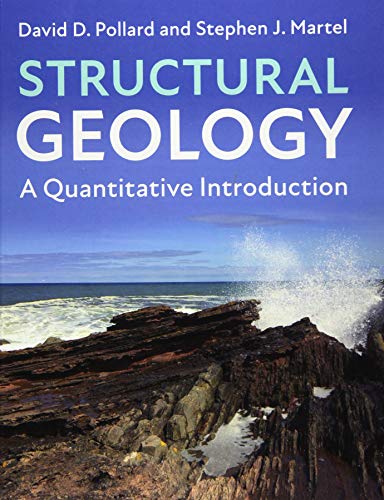Structural Geology: A Quantitative Introduction Paperback – July 23, 2020 by David D. Pollard , Stephen J. Martel
PAPERBACK
[450 pages]
PUB: July 23, 2020
Description
Author: Pollard David D.
Brand: Cambridge University Press
Edition: 1
Package Dimensions: 24x281x1470
Number Of Pages: 450
Release Date: 01-07-2020
Details: Product Description
Tackling structural geology problems today requires a quantitative understanding of the underlying physical principles, and the ability to apply mathematical models to deformation processes within the Earth. Accessible yet rigorous, this unique textbook demonstrates how to approach structural geology quantitatively using calculus and mechanics, and prepares students to interface with professional geophysicists and engineers who appreciate and utilize the same tools and computational methods to solve multidisciplinary problems. Clearly explained methods are used throughout the book to quantify field data, set up mathematical models for the formation of structures, and compare model results to field observations. An extensive online package of coordinated laboratory exercises enables students to consolidate their learning and put it into practice by analyzing structural data and building insightful models. Designed for single-semester undergraduate courses, this pioneering text prepares students for graduates studies and careers as professional geoscientists.
Review
‘This textbook is an excellent introduction to quantitative structural geology, showing the formation of structures using both calculus and mechanics. The book bridges the gap between descriptive structural geology books and more advanced textbooks requiring a continuum mechanics background, and will be a ‘must’ for all geoscientists who wish to learn how to interpret geological structures based on fundamental physical principles.’ Bernhard Grasemann, University of Vienna
‘Pollard and Martel have written the ‘Turcotte and Schubert’ of structural geology. Their treatment, focusing on quantitative analysis of canonical examples, is unique, and their respect for structural geology is demonstrated by copious use of maps and field examples. The text is suitable for upper-level undergraduates with a strong math or engineering background, and is essential for all graduate students and professors of structural geology.’ Richard Allmendinger, Cornell University
‘This textbook tackles head-on the difficult task of quantifying the deformation processes operating in the Earth’s crust in a manner that can be understood by readers without a strong mathematical background. Clearly written and beautifully illustrated with a plethora of useful and interesting diagrams and photographs – the authors are to be congratulated on producing a book that will become one of the standard structural texts for the next decade.’ John Cosgrove, Imperial College London
Book Description
A pioneering single-semester undergraduate textbook that balances descriptive and quantitative analysis of geological structures.
About the Author
David D. Pollard is a Professor Emeritus in Geology at Stanford University. He holds a Ph.D. in Geology from Stanford University and a Diploma of Imperial College (University of London). He has been on the faculty at Stanford since 1983, where he taught an undergraduate course in structural geology, from which this textbook emerged. He co-authored Fundamentals of Structural Geology, published by Cambridge University Press in 2005, which won the Best Publication of the Year Award from the Structural Geology and Tectonics Division of the Geological Society of America in 2007. He is a Fellow of the Geological Society of America and the American Geophysical Union.
Stephen J. Martel is a Professor in Geology and Geophysics at the University of Hawaiʻi. He holds a Ph.D. in Applied Earth Sciences from Stanford University. Since joining the faculty in Hawai’I in 1992, he has taught both structural geology and engineering geology. He previously worked at the Bureau of Economic Geology at the University of Texas, and at Lawrence Berkeley National Laboratory. Particular research interests of his include landslides, nuclear waste disposal, neotectonics, fault mechanics, rock fracture, detailed geologic mapping, and the in































There are no reviews yet.